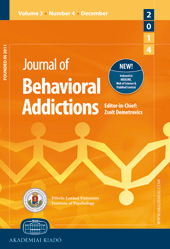Gambling disorder in financial markets: Clinical and treatment-related features
Gambling disorder in financial markets: Clinical and treatment-related features
Author(s): Young-Chul Shin, Sam-Wook Choi, Juwon Ha, Jung-Seok Choi, Dai-Jin KimSubject(s): Clinical psychology, Behaviorism, Substance abuse and addiction, Financial Markets, Socio-Economic Research
Published by: Akadémiai Kiadó
Keywords: gambling disorder; financial market; horse race; clinical features; treatment;
Summary/Abstract: To date, few studies have examined the clinical manifestation of disordered gamblers in financial markets. This study examined the differences in the clinical and treatment-related features of gambling disorder between financial markets and horse races. Methods: Subjects who met the DSM-IV criteria for pathological gambling (PG) and who sought treatment were assessed by retrospective chart review. One hundred forty-four subjects were included in this sample, which consisted of the following groups: financial markets (n = 45; 28.6%) and horse races (n = 99; 71.4%). Results: Multiple similar manifestations were found between the groups, including severity of PG, age of PG onset, amounts of gambling debts, drinking days per week, depressive mood, duration of seeking treatment after the onset of PG, and treatment follow-up duration. However, disordered gamblers who invested in the financial market were significantly more likely to be educated (p = 0.003), live with their spouses (p = 0.007), have full-time jobs (p = 0.006), and they were more likely to participate in the first type of gambling than the horse races group (p < 0.001). Furthermore, the financial markets group received the anti-craving medication less often than the horse races group (p = 0.04). Discussion and Conclusions: These findings suggest that disordered gamblers in financial markets show different socio-demographic, clinical and treatment-related features compared with the horse race gamblers, despite a similar severity of gambling disorder. Understanding these differential manifestations may provide insight into prevention and treatment development for specific types of gambling.
Journal: Journal of Behavioral Addictions
- Issue Year: 4/2015
- Issue No: 4
- Page Range: 244-249
- Page Count: 6
- Language: English

